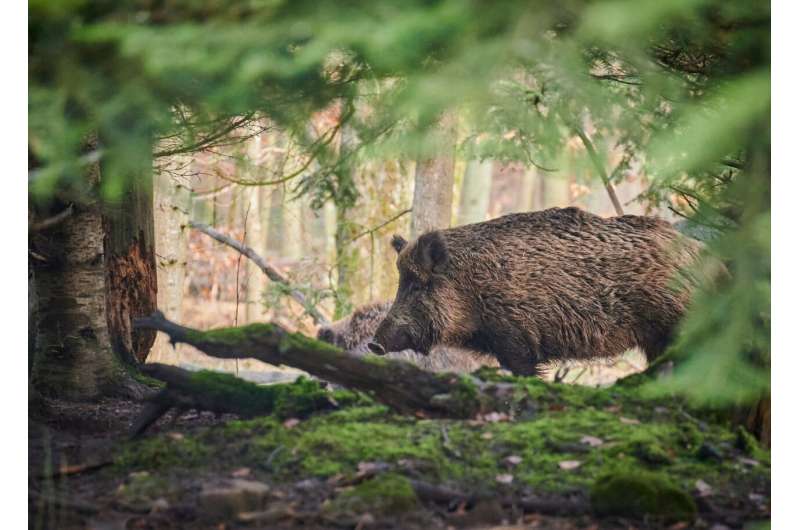This article has been reviewed according to Science X's editorial process and policies. Editors have highlighted the following attributes while ensuring the content's credibility:
fact-checked
peer-reviewed publication
trusted source
proofread
National park wild boar contain five-times more toxic PFAS than humans allowed to eat, study finds

Wild boar in a European national park have been found to contain levels of toxic PFAS "forever chemicals" nearly five-times higher than is allowed to be sold in meat for human consumption under EU law, according to a new study.
The work, by experts in PFAS at The James Hutton Institute in Aberdeen and the University of Graz in Austria, was carried out to assess background levels of the chemicals in the environment, using wild boar from the Bohemian Forest National Park in the Czech Republic as "bio-indicators." The research is published in the journal Science of The Total Environment.
It found that, compared to an earlier study of wild boar in a rural area of north-east Germany, the boar in the park contained twice as much PFAS.
There are more than 12,000 PFAS, dubbed "forever chemicals" due to how long they take to degrade, which are widely used in household products but linked with serious health concerns including cancer, fertility issues and liver damage.
Viktoria Müller, a researcher at the Hutton, who supported the study as part of her Ph.D. research at the University of Graz, says, "The level of contamination in the wild boar in the national park is a cause for concern. We are now finding PFAS everywhere, but that it's at levels above those allowed for human consumption in food—and wild boar meat and offal is consumed by humans—is a worry.
"However, pinpointing why the levels were higher in the park would need a bigger study. The profile of the types of PFAS found in the park matched those generally found at 'background' levels, suggesting atmospheric deposition, from rain and wind for example. But the high concentrations we found suggest deeper investigation is needed."
Recent work by researchers at the Hutton, which specializes in land and environmental science, has found PFAS on Austrian ski slopes and in the River Yangzte, largely due to food packaging and textile treatment.
For the most recent research, the livers from 30 wild boar, caught as part of annual population control at the park, were tested for 30 different PFAS. The median amounts found in the liver—which accumulate compounds like PFAS—were 230μg/kg, near five times the maximum amount allowed in game offal under EU laws on PFAS content in food.
The EU regulation was introduced in 2023 and regulates concentrations of PFAS in food across vegetables, fish and meat, including game, with game offal having the highest levels allowed.
Wild boar were studied for PFAS levels because they are seen as good indicators of "background" levels of PFAS in the environment. This is because they eat most things, including plants and small animals, as well as soil, which can be a major source of PFAS, as they root about for their food.
The park, also known as Šumava National Park, has been a protected site since 1963 and has a population of around 400 wild boar, which is controlled, allowing the researchers to access liver samples. The park borders Germany, close to the Bavarian Forest National Park.
Wild boar meat is currently eaten, often as game, with its popularity varying from region to region. Germany, Italy and France more commonly eat the meat, but it's also eaten in Spain and Eastern European countries.
More information: Till Schröder et al, Fluorine mass balance analysis in wild boar organs from the Bohemian Forest National Park, Science of The Total Environment (2024). DOI: 10.1016/j.scitotenv.2024.171187
Journal information: Science of the Total Environment
Provided by The James Hutton Institute





















